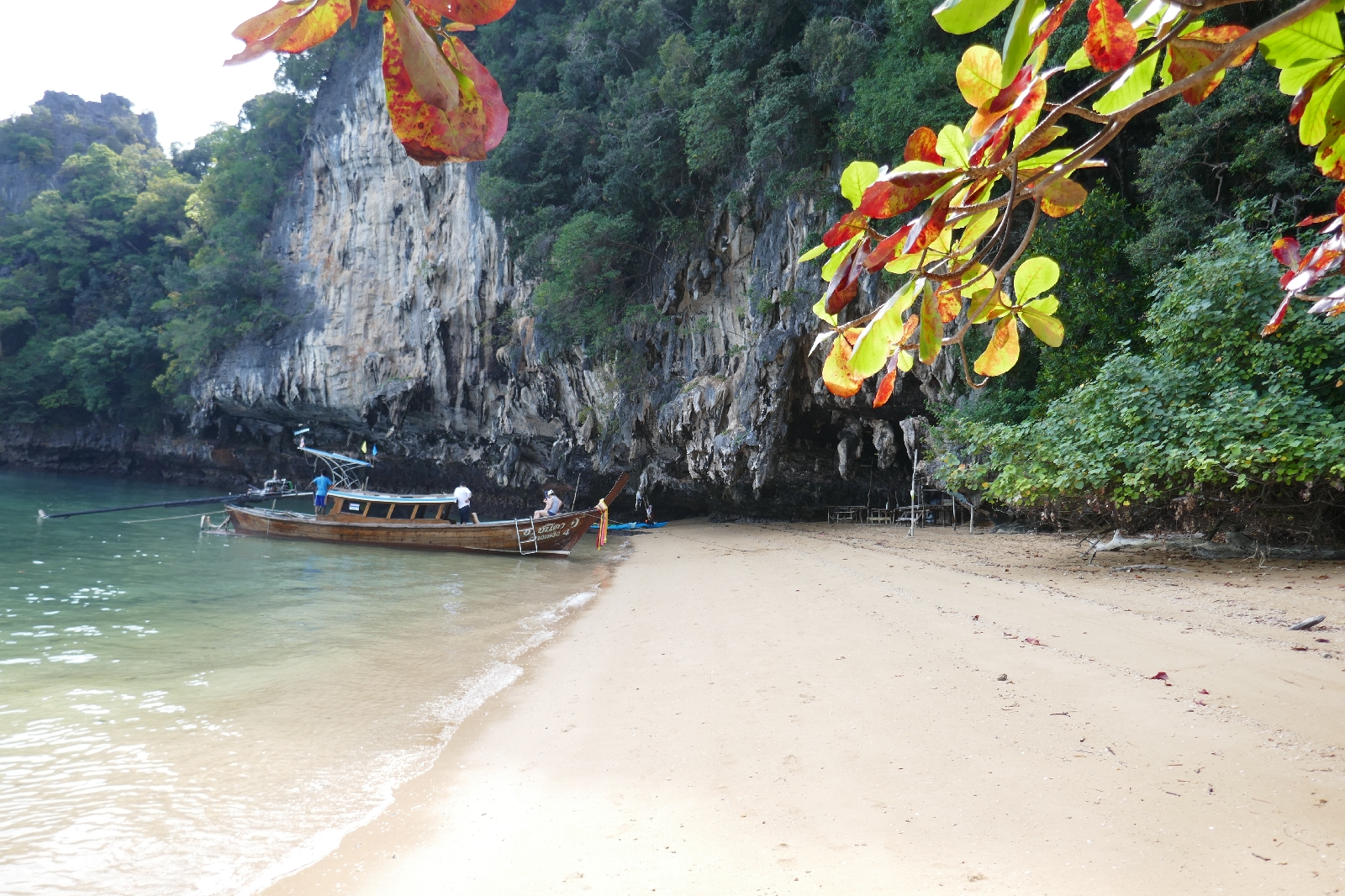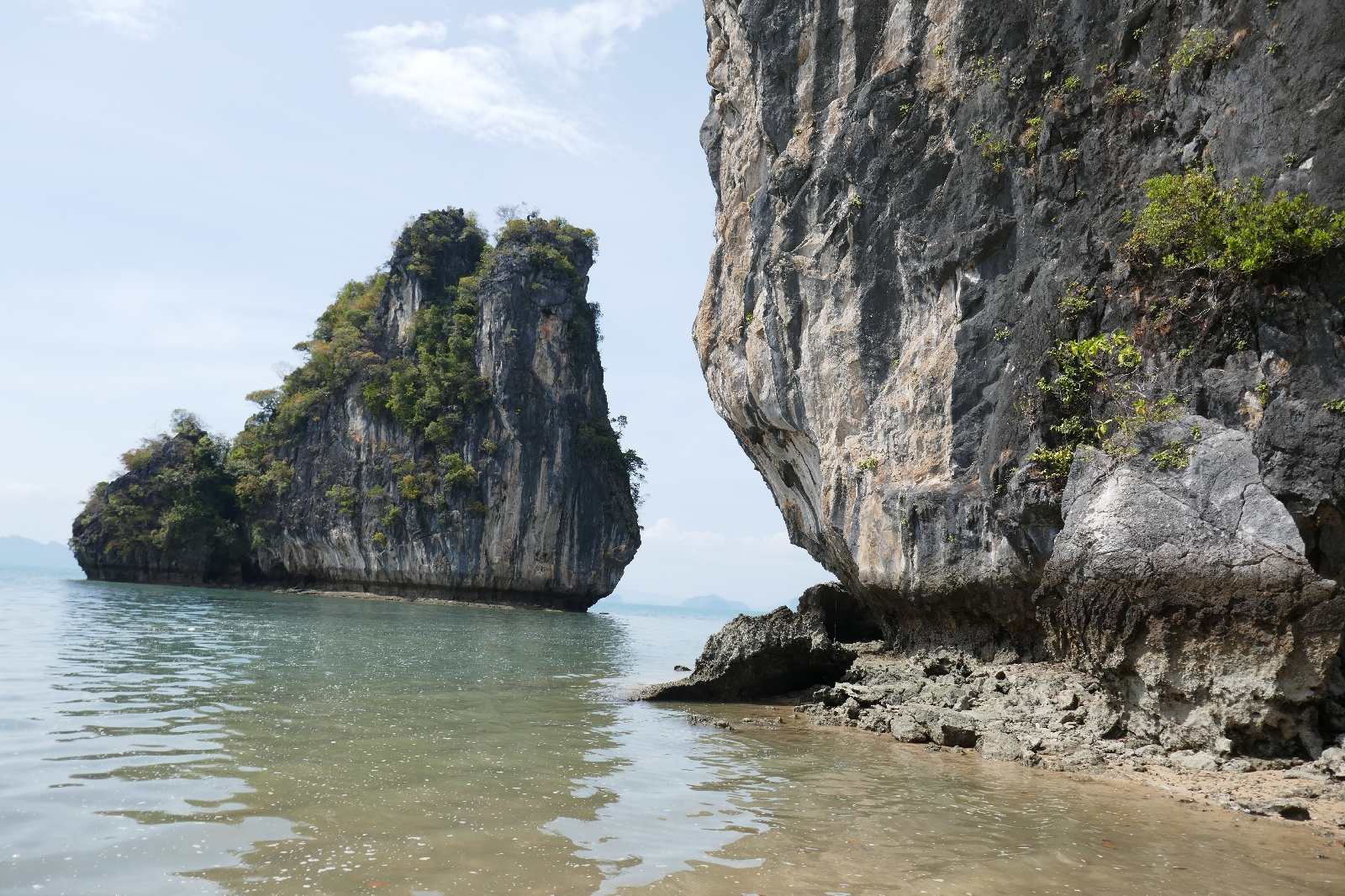January 17, 2023
Thailand extends south about halfway down the Malay Penninsula. Phuket island is on the west side enclosing Phang Nga (pronounced "naah"), Bay. Kayaking trips are organized from No Yao Noi Island. Getting to the kayak launch from Phuket town involved riding in or on: a van, a speed boat, a pickup truck bed
with seats, the back of a motor scooter, and the cab of a pickup truck from the 1980s. We drove past a seaside "floating" village on stilts. The island has 4,000 residents, and "no secrets" because everybody knows each other their whole lives, according to Aryuen (Run) my kayak guide, who is married to a local island woman.
We launched from An Pao pier, on the northwest of the island. I had two kayak options: a very stable boat that was a bit too small, or a tippier boat (1) that was a looser fit; I opted for the latter (2). We paddled north hugging the limestone cliffs rimming the Island. The constant sound of cicadas varied around the island from a gentle buzz to a sound like a metal grinding factory, as we watched hornbills, hawks and blue herons fly or soar by the cliffs. A short hike from the beach at a small cove called "big tree bay" brought us to the bay's namesake.
The guide had been assessing my skill on his initial stretch. He deemed a support boat (3) unnecessary and was comfortable bringing me into open water. A current was running inbound (4) so we aimed high for the 3+ mile open water crossing to Ko Khui Island. At the south end of the island (in Phang Nga National Park), a stalagtite high on the cliff had the distinct shape of an elephant head and trunk. A small beach on the east side of the bay offered a pull-out for lunch, which had been made by Run's mother.
After poking into a lagoon with mangroves, we rounded the north end of the island. The return was 5+ miles of open water, a vigorous pull into the afternoon's southwest wind. We pulled out an An Pao beach which was accessible now because the tide had come in. The water here was green and turbid and was crazy warm (5). "It's coconut o'clock" Aryuen said, emerging from a nearby fruit stand with a coconut with a straw sticking out.
At dusk, I went looking for dinner in the small town. A woman on the sidewalk with a wok and a few tables offered a very tasty meal. While eating, a local boy kept running around the place. "Busy boy," I said to the parents who laughed before the whole family (dad, mom (clad in a full black dress and hijab) and two boys) rode off on their motor scooter. At dusk, the muezzin's call to prayer rang out from multiple mosques in the island (6).
(1) Kayak designers talk about "initial stability" when discussing tippiness.
(2) While sea kayaks are supposed to fit like a glove, I prefer the baggy pants feel. I soon discovered what many first time bike-riders also discover: the counterintuitive finding that going faster makes for a safer and more stable ride; the boat settled down nicely while underway, and I managed to avoid flipping the boat (a).
(a) Falling out at the beach doesn't count. No danger there, just wounded pride.
(3) Trips are normally accompanied by a wooden long-tail boat, a traditional Thai design, as an added measure of safety. When we first met, Run asked if I had kayaked before. Many people who sign up have never paddled; "Pressure for me on those days," he said (b).
(b) I picked this particular kayak company because they have real sea kayaks, not sit on tops, which are slower, clunkier and hard to maneuver (i). However for a tour company, an advantage of the sit on tops is that they are more forgiving for newbies, being harder to tip and easier to get back on if capsized.
(i) The company website says they use "proper" sea kayaks, not "sluggish sit on tops."
(4) The U shaped bay funnels water into the bay yielding tides in the 2 meter range (about 6.5 feet) during the quarter moons (neap tides), while the bi-monthly spring tides (during the full and new moons) run closer to 3 meters (about 10 feet). Today being just past the last quarter, the tidal range was close to 2 meters.
(5) The water here is very shallow and responds quickly to the afternoon sun. I would have turned the hot water down in the tub's faucet if it were this warm.
(6) While Buddhism is the official religion of Thailand, the constitution guarantees freedom of religion. While Muslins represent less than 5% of the whole Thai population, Ko Yai Noi's population is almost entirely so.
Ready to launch, An Pao floating dock
Iron-stained sandstone cliffs
Why it's called Big Tree Bay
Looking up at the elephant-trunk stalagtite, south end of Ko Khlui Island
Getting petrol on the island is a two-for: you get exercise from the hand pump and fuel for your scooter. The hand pump extracts the fuel from the drums into a cylinder on top, from which gravity feeds it into your tank. While seemingly ad-hoc, it is more official than in Cambodia, where many road side stands sell petrol in old glass whiskey or gin bottles. How the gas gets into the liquor bottles, I do not know.
Tapping the rubber trees on Ko Yao Noi

















































